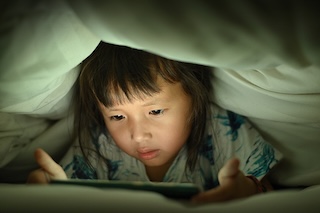 A new study published in the Journal of Sleep Health looked at the social epidemiology of bedtime screen use behaviors and sleep outcomes in early adolescence.
A new study published in the Journal of Sleep Health looked at the social epidemiology of bedtime screen use behaviors and sleep outcomes in early adolescence.
“Our study looks at bedtime screen habits in early adolescents, with a focus on the associations between screen use at bedtime and sleep outcomes,” study author Jason M. Nagata told us. “We were hoping to find out how many tweens have devices in their bedrooms, how many are woken up by notifications from these devices in the nighttime, and how many continued to use their device after being woken up by notifications and before going back to sleep. We also looked at the sociodemographic differences in bedtime screen use, with the hopes of observing sleep outcomes in at-risk populations to inform future clinical recommendations.”
Prior findings had shown that nearly all adolescents report having some sort of electronic device in their bedroom at night, including phones, televisions, video games, and music players. Previous literature had also looked at racial and ethnic differences in total screen time across all age ranges with a limited number of studies also observing sex differences in bedtime screen usage.
Based on these findings, the researchers hypothesized that female adolescents, racial/ethnic minorities, sexual minorities, and those who live in low-income households would have more bedtime screen use. They also hypothesized that screen use happening specifically at bedtime would be associated with shorter duration of sleep and more sleep disturbance.
“Few, if any, prior studies have examined sociodemographic associations with bedtime screen use in adolescents,” Nagata told us. “Additionally, no studies at the time had investigated potential associations between sexual orientation and bedtime screen use. We aimed to address this gap in literature.”
The researchers used data from the Adolescent Brain Cognitive Development (ABCD) Study, a large, demographically diverse sample of adolescents from across the United States. All participants were either nine- or ten-years-old at baseline. The data was analyzed using a cross-sectional approach from the Year 3 follow-up, during which most participants were 12-13 years of age.
Sociodemographic variables were self-reported by the parent or guardian during the baseline assessment, including sex, race/ethnicity, household income, parental education status, number of siblings in the household, and COVID-19 pandemic time period. Screen time variables included bedtime screen usage and overall screen usage, and sleep variables included the Sleep Disturbance Scale for Children and the Munich Chronotype Questionnaire.
“We found that several key sociodemographic factors were linked to bedtime screen use,” Nagata told us. “With the exception of video games, girls had more bedtime screen usage than boys across all modalities.”
The study found that Asian adolescents had lower total bedtime screen usage in comparison to White adolescents, while adolescents who identified as Black, Latino/Hispanic, Native American, and other races/ethnicities had higher total bedtime screen usage compared to White adolescents. Sexual minority adolescents also had greater total bedtime screen usage versus their heterosexual peers. Increased bedtime screen usage was also associated with lower household income and reduced parental education levels.
“Our findings aligned with the limited amount of previous literature observing bedtime screen usage and sociodemographic differences associated with this,” Nagata told us. “Though these results may not be surprising, they are staggering in that a large majority of tweens have Internet-connected devices in their bedrooms (70%). The sociodemographic differences amongst minority versus non-minority populations when it comes to total bedtime screen usage can also serve as crucial information for recommendations going forward.”
Nagata believes these findings carry several meaningful clinical and policy implications concerning bedtime screen use in adolescents. Based on these results, the American Academy of Pediatrics Family Media Use Plan can further highlight the importance of reducing screen time and exposure before bedtime. Clinicians can now offer targeted advice to sexual, ethnic, and racial minority populations to help limit bedtime screen usage. Culturally-tailored messaging can also now be employed within schools and communities, in order to reach and engage younger children in positive alternatives to pre-bedtime activities.
“Some advice to promote better sleep habits in adolescents includes keeping phones and other types of technology completely outside of the bedroom, as this is the best way to get the highest quality sleep,” Nagata told us. “If a phone or other device needs to remain inside the bedroom, turning it off completely is the next best thing. Tweens leaving their phone or device on silent or vibrate may still tempt them to check notifications or messages during the nighttime, which leads to poorer quality of sleep.”
Patricia Tomasi is a mom, maternal mental health advocate, journalist, and speaker. She writes regularly for the Huffington Post Canada, focusing primarily on maternal mental health after suffering from severe postpartum anxiety twice. You can find her Huffington Post biography here. Patricia is also a Patient Expert Advisor for the North American-based, Maternal Mental Health Research Collective and is the founder of the online peer support group – Facebook Postpartum Depression & Anxiety Support Group – with over 1500 members worldwide. Blog: www.patriciatomasiblog.wordpress.com
Email: tomasi.patricia@gmail.com









